

Oil & Gas Geology ›› 2024, Vol. 45 ›› Issue (5): 1305-1320.doi: 10.11743/ogg20240508
• Petroleum Geology • Previous Articles Next Articles
Hong ZHANG1( ), Youliang FENG1, Chang LIU1, Zhi YANG1, Kunyu WU2, Guohui LONG2, Jianhuan YAO3, Bowen MENG1, Haoting XING2, Wenqi JIANG4, Xiaoni WANG1, Qizhao WEI1
), Youliang FENG1, Chang LIU1, Zhi YANG1, Kunyu WU2, Guohui LONG2, Jianhuan YAO3, Bowen MENG1, Haoting XING2, Wenqi JIANG4, Xiaoni WANG1, Qizhao WEI1
Received:2024-03-06
Revised:2024-10-08
Online:2024-10-30
Published:2024-11-06
CLC Number:
Hong ZHANG, Youliang FENG, Chang LIU, Zhi YANG, Kunyu WU, Guohui LONG, Jianhuan YAO, Bowen MENG, Haoting XING, Wenqi JIANG, Xiaoni WANG, Qizhao WEI. Dominant lithofacies and factors controlling reservoir formation of the shale sequence in the upper member of the Paleogene Lower Ganchaigou Formation, Ganchaigou area, Qaidam Basin[J]. Oil & Gas Geology, 2024, 45(5): 1305-1320.
Add to citation manager EndNote|Reference Manager|ProCite|BibTeX|RefWorks
Table 1
Qualitative to semiquantitative identification results of micro- to nano-scale matrix pore systems in different lithofacies of the E32 in well CP2, Ganchaigou area"
| 岩相类型 | 孔隙类型 | 高分辨率 扫描电镜图像 | 基质孔隙系统 (扫描电镜图像孔隙提取) | 大面积视域统计孔径 分布情况 | 面孔率/ % | 孔径分布/nm | 峰值 孔径/nm |
|---|---|---|---|---|---|---|---|
块状灰云岩 (埋深 2 755.44 m) | 晶间孔 粒间溶孔粒内溶孔 | 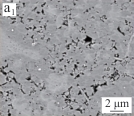 | 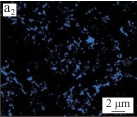 | 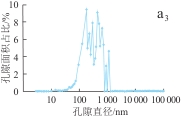 | 5.83 | 11.00 ~ 1 088.00 (85.00) | 181.09 |
| 454.29 | |||||||
层状灰云岩 (埋深 2 749.10 m) | 晶间孔 粒内溶孔 |  | 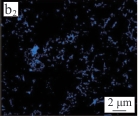 | 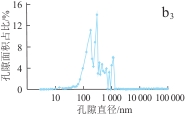 | 4.50 | 11.02 ~ 1083.93 (302.67) | 302.67 |
| 断续状水平层理混积岩(埋深 2 752.29 m) | 粒间残余孔 粒内溶孔 | 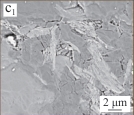 | 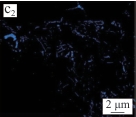 | 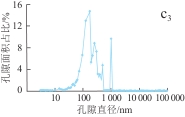 | 2.14 | 11.00 ~ 952.00 (52.00) | 181.09 |
纹层状 混积岩 (埋深 2 759.94 m) | 粒间残余孔 粒内溶孔 |  | 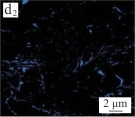 | 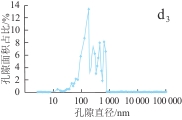 | 3.07 | 11.00 ~ 679.00 (51.00) | 181.09 |
Table 2
Statistics of nitrogen adsorption experiment-derived fractal dimensions of reservoirs of different lithofacies in the E32, Ganchaigou area"
| 岩相 | 样品编号 | 微孔 | 中孔+宏孔 | 分形维数平均值 | ||
|---|---|---|---|---|---|---|
| D1 | R2 | D2 | R2 | |||
| 块状灰云岩 | CP2-6 | 1.993 7 | 0.948 5 | 2.602 4 | 0.995 7 | 2.298 1 |
| 层状灰云岩 | CP2-4 | 2.008 6 | 0.955 6 | 2.607 5 | 0.991 6 | 2.308 1 |
| 纹层状混积岩 | CP2-21 | 1.870 7 | 0.943 6 | 2.640 8 | 0.997 9 | 2.255 8 |
| 断续状水平层理混积岩 | CP2-11 | 2.266 1 | 0.982 7 | 2.579 4 | 0.992 9 | 2.422 8 |
| 1 | 金之钧, 白振瑞, 高波, 等. 中国迎来页岩油气革命了吗?[J]. 石油与天然气地质, 2019, 40(3): 451-458. |
| JIN Zhijun, BAI Zhenrui, GAO Bo, et al. Has China ushered in the shale oil and gas revolution?[J]. Oil & Gas Geology, 2019, 40(3): 451-458. | |
| 2 | 邹才能, 潘松圻, 荆振华, 等. 页岩油气革命及影响[J]. 石油学报, 2020, 41(1): 1-12. |
| ZOU Caineng, PAN Songqi, JING Zhenhua, et al. Shale oil and gas revolution and its impact[J]. Acta Petrolei Sinica, 2020, 41(1): 1-12. | |
| 3 | 赵贤正, 周立宏, 蒲秀刚, 等. 湖相页岩型页岩油勘探开发理论技术与实践——以渤海湾盆地沧东凹陷古近系孔店组为例[J]. 石油勘探与开发, 2022, 49(3): 616-626. |
| ZHAO Xianzheng, ZHOU Lihong, PU Xiugang, et al. Theories, technologies and practices of lacustrine shale oil exploration and development: A case study of Paleogene Kongdian Formation in Cangdong Sag, Bohai Bay Basin, China[J]. Petroleum Exploration and Development, 2022, 49(3): 616-626. | |
| 4 | 赵文智, 胡素云, 侯连华, 等. 中国陆相页岩油类型、资源潜力及与致密油的边界[J]. 石油勘探与开发, 2020, 47(1): 1-10. |
| ZHAO Wenzhi, HU Suyun, HOU Lianhua, et al. Types and resource potential of continental shale oil in China and its boundary with tight oil[J]. Petroleum Exploration and Development, 2020, 47(1): 1-10. | |
| 5 | 黎茂稳, 马晓潇, 金之钧, 等. 中国海、陆相页岩层系岩相组合多样性与非常规油气勘探意义[J]. 石油与天然气地质, 2022, 43(1): 1-25. |
| LI Maowen, MA Xiaoxiao, JIN Zhijun, et al. Diversity in the lithofacies assemblages of marine and lacustrine shale strata and significance for unconventional petroleum exploration in China[J]. Oil & Gas Geology, 2022, 43(1): 1-25. | |
| 6 | 邹才能, 朱如凯, 白斌, 等. 致密油与页岩油内涵、特征、潜力及挑战[J]. 矿物岩石地球化学通报, 2015, 34(1): 1-17. |
| ZOU Caineng, ZHU Rukai, BAI Bin, et al. Significance, geologic characteristics, resource potential and future challenges of tight oil and shale oil[J]. Bulletin of Mineralogy, Petrology and Geochemistry, 2015, 34(1): 1-17. | |
| 7 | 邹才能, 冯有良, 杨智, 等. 中国湖盆细粒重力流沉积作用及其对页岩油 “甜点段” 发育的影响[J]. 石油勘探与开发, 2023, 50(5): 883-897. |
| ZOU Caineng, FENG Youliang, YANG Zhi, et al. Fine-grained gravity flow sedimentation and its influence on development of shale oil sweet spot intervals in lacustrine basins in China[J]. Petroleum Exploration and Development, 2023, 50(5): 883-897. | |
| 8 | 焦方正, 邹才能, 杨智. 陆相源内石油聚集地质理论认识及勘探开发实践[J]. 石油勘探与开发, 2020, 47(6): 1067-1078. |
| JIAO Fangzheng, ZOU Caineng, YANG Zhi. Geological theory and exploration & development practice of hydrocarbon accumulation inside continental source kitchens[J]. Petroleum Exploration and Development, 2020, 47(6): 1067-1078. | |
| 9 | 郭泽清, 龙国徽, 周飞, 等. 咸化湖盆页岩油地质特征及资源潜力评价方法——以柴西坳陷下干柴沟组上段为例[J]. 地质学报, 2023, 97(7): 2425-2444. |
| GUO Zeqing, LONG Guohui, ZHOU Fei, et al. Geological characteristics and resource evaluation method for shale oil in a salinized lake basin: A case study from the upper member of the Lower Ganchaigou Formation in western Qaidam Depression[J]. Acta Geologica Sinica, 2023, 97(7): 2425-2444. | |
| 10 | 王永诗, 李政, 王民, 等. 渤海湾盆地济阳坳陷陆相页岩油吸附控制因素[J]. 石油与天然气地质, 2022, 43(3): 489-498. |
| WANG Yongshi, LI Zheng, WANG Min, et al. Factors controlling lacustrine shale oil adsorption in the Jiyang Depression, Bohai Bay Basin[J]. Oil & Gas Geology, 2022, 43(3): 489-498. | |
| 11 | 赵文智, 朱如凯, 刘伟, 等. 我国陆相中高熟页岩油富集条件与分布特征[J]. 地学前缘, 2023, 30(1): 116-127. |
| ZHAO Wenzhi, ZHU Rukai, LIU Wei, et al. Lacustrine medium-high maturity shale oil in onshore China: Enrichment conditions and occurrence features[J]. Earth Science Frontiers, 2023, 30(1): 116-127. | |
| 12 | 冯有良, 杨智, 张洪, 等. 咸化湖盆细粒重力流沉积特征及其页岩油勘探意义——以准噶尔盆地玛湖凹陷风城组为例[J]. 地质学报, 2023, 97(3): 839-863. |
| FENG Youliang, YANG Zhi, ZHANG Hong, et al. Fine-grained gravity flow sedimentary features and their petroleum significance within saline lacustrine basins: A case study of the Fengcheng Formation in Mahu Depression, Junggar Basin, China[J]. Acta Geologica Sinica, 2023, 97(3): 839-863. | |
| 13 | 张国印, 王志章, 郭旭光, 等. 准噶尔盆地乌夏地区风城组云质岩致密油特征及“甜点”预测[J]. 石油与天然气地质, 2015, 36(2): 219-229. |
| ZHANG Guoyin, WANG Zhizhang, GUO Xuguang, et al. Characteristics and ‘sweet spot’ prediction of dolomitic tight oil reservoirs of the Fengcheng Formation in Wuxia area, Junggar Basin[J]. Oil & Gas Geology, 2015, 36(2): 219-229. | |
| 14 | 李国欣, 朱如凯, 张永庶, 等. 柴达木盆地英雄岭页岩油地质特征、评价标准及发现意义[J]. 石油勘探与开发, 2022, 49(1): 18-31. |
| LI Guoxin, ZHU Rukai, ZHANG Yongshu, et al. Geological characteristics, evaluation criteria and discovery significance of Paleogene Yingxiongling shale oil in Qaidam Basin, NW China[J]. Petroleum Exploration and Development, 2022, 49(1): 18-31. | |
| 15 | 李国欣, 伍坤宇, 朱如凯, 等. 巨厚高原山地式页岩油藏的富集模式与高效动用方式——以柴达木盆地英雄岭页岩油藏为例[J]. 石油学报, 2023, 44(1): 144-157. |
| LI Guoxin, WU Kunyu, ZHU Rukai, et al. Enrichment model and high-efficiency production of thick plateau mountainous shale oil reservoir: A case study of the Yingxiongling shale oil reservoir in Qaidam Basin[J]. Acta Petrolei Sinica, 2023, 44(1): 144-157. | |
| 16 | 杨智峰, 唐勇, 郭旭光, 等. 准噶尔盆地玛湖凹陷二叠系风城组页岩油赋存特征与影响因素[J]. 石油实验地质, 2021, 43(5): 784-796. |
| YANG Zhifeng, TANG Yong, GUO Xuguang, et al. Occurrence states and potential influencing factors of shale oil in the Permian Fengcheng Formation of Mahu Sag, Junggar Basin[J]. Petroleum Geology and Experiment, 2021, 43(5): 784-796. | |
| 17 | 何文渊, 白雪峰, 蒙启安, 等. 四川盆地陆相页岩油成藏地质特征与重大发现[J]. 石油学报, 2022, 43(7): 885-898. |
| HE Wenyuan, BAI Xuefeng, MENG Qi’an, et al. Accumulation geological characteristics and major discoveries of lacustrine shale oil in Sichuan Basin[J]. Acta Petrolei Sinica, 2022, 43(7): 885-898. | |
| 18 | 完颜泽, 龙国徽, 杨巍, 等. 柴达木盆地英雄岭地区古近系油气成藏过程及其演化特征[J]. 岩性油气藏, 2023, 35(2): 94-102. |
| WANYAN Ze, LONG Guohui, YANG Wei, et al. Hydrocarbon accumulation and evolution characteristics of Paleogene in Yingxiongling area, Qaidam Basin[J]. Lithologic Reservoirs, 2023, 35(2): 94-102. | |
| 19 | 张绍. 柴达木英西地区储层特征及油气成藏[D]. 北京: 中国石油大学(北京), 2019: 50-72. |
| ZHANG Shao. The reservoir characteristics and hydrocarbon accumulation in Yingxi area of Qaidam Basin[D]. Beijing: China University of Petroleum(Beijing), 2019: 50-72. | |
| 20 | 刘占国, 张永庶, 宋光永, 等. 柴达木盆地英西地区咸化湖盆混积碳酸盐岩岩相特征与控储机制[J]. 石油勘探与开发, 2021, 48(1): 68-80. |
| LIU Zhanguo, ZHANG Yongshu, SONG Guangyong, et al. Mixed carbonate rocks lithofacies features and reservoirs controlling mechanisms in the saline lacustrine basin in Yingxi area, Qaidam Basin, NW China[J]. Petroleum Exploration and Development, 2021, 48(1): 68-80. | |
| 21 | 张道伟, 薛建勤, 伍坤宇, 等. 柴达木盆地英西地区页岩油储层特征及有利区优选[J]. 岩性油气藏, 2020, 32(4): 1-11. |
| ZHANG Daowei, XUE Jianqin, WU Kunyu, et al. Shale oil reservoir characteristics and favorable area optimization in Yingxi area, Qaidam Basin[J]. Lithologic Reservoirs, 2020, 32(4): 1-11. | |
| 22 | 郭得龙, 申颍浩, 林海, 等. 柴达木盆地英雄岭页岩油CP1井压裂后甜点分析[J]. 中国石油勘探, 2023, 28(4): 117-128. |
| GUO Delong, SHEN Yinghao, LIN Hai, et al. Post fracturing shale oil sweet spot evaluation in Well CP1 in Yingxiongling area, Qaidam Basin[J]. China Petroleum Exploration, 2023, 28(4): 117-128. | |
| 23 | 谢贵琪, 林海, 刘世铎, 等. 柴达木盆地西部英雄岭页岩油地质工程一体化压裂技术创新与实践[J]. 中国石油勘探, 2023, 28(4): 105-116. |
| XIE Guiqi, LIN Hai, LIU Shiduo, et al. Innovation and practice of geology and engineering integrated fracturing technology for shale oil in Yingxiongling area in the western Qaidam Basin[J]. China Petroleum Exploration, 2023, 28(4): 105-116. | |
| 24 | 夏青松, 陆江, 杨鹏, 等. 柴达木盆地英西地区渐新统下干柴沟组上段储层微观孔隙结构特征[J]. 岩性油气藏, 2023, 35(1): 132-144. |
| XIA Qingsong, LU Jiang, YANG Peng, et al. Microscopic pore structure characteristics of the upper member of Oligocene Xiaganchaigou Formation in Yingxi area, Qaidam Basin[J]. Lithologic Reservoirs, 2023, 35(1): 132-144. | |
| 25 | 崔俊, 毛建英, 赵为永, 等. 柴达木盆地英雄岭页岩纹层结构特征及石油地质意义[J]. 中国石油勘探, 2023, 28(5): 43-53. |
| CUI Jun, MAO Jianying, ZHAO Weiyong, et al. Characteristics of laminated texture and petroleum geological significance of Yingxiongling shale in Qaidam Basin[J]. China Petroleum Exploration, 2023, 28(5): 43-53. | |
| 26 | 龙国徽, 王艳清, 朱超, 等. 柴达木盆地英雄岭构造带油气成藏条件与有利勘探区带[J]. 岩性油气藏, 2021, 33(1): 145-160. |
| LONG Guohui, WANG Yanqing, ZHU Chao, et al. Hydrocarbon accumulation conditions and favorable exploration plays in Yingxiongling structural belt, Qaidam Basin[J]. Lithologic Reservoirs, 2021, 33(1): 145-160. | |
| 27 | 张斌, 何媛媛, 陈琰, 等. 柴达木盆地西部咸化湖相优质烃源岩形成机理[J]. 石油学报, 2018, 39(6): 674-685. |
| ZHANG Bin, HE Yuanyuan, CHEN Yan, et al. Formation mechanism of excellent saline lacustrine source rocks in western Qaidam Basin[J]. Acta Petrolei Sinica, 2018, 39(6): 674-685. | |
| 28 | 翟光明. 中国石油地质志(卷一): 总论[M]. 北京: 石油工业出版社, 1996. |
| ZHAI Guangming. Petroleum geology of China (Volume 1): General introduction[M]. Beijing: Petroleum Industry Press, 1996. | |
| 29 | 王民, 关莹, 李传明, 等. 济阳坳陷沙河街组湖相页岩储层孔隙定性描述及全孔径定量评价[J]. 石油与天然气地质, 2018, 39(6): 1107-1119. |
| WANG Min, GUAN Ying, LI Chuanming, et al. Qualitative description and full-pore-size quantitative evaluation of pores in lacustrine shale reservoir of Shahejie Formation, Jiyang Depression[J]. Oil & Gas Geology, 2018, 39(6): 1107-1119. | |
| 30 | SING K S W. Reporting physisorption data for gas/solid systems with special reference to the determination of surface area and porosity (Recommendations 1984)[J]. Pure and Applied Chemistry, 1985, 57(4): 603-619. |
| 31 | 杨峰, 宁正福, 孔德涛, 等. 高压压汞法和氮气吸附法分析页岩孔隙结构[J]. 天然气地球科学, 2013, 24(3): 450-455. |
| YANG Feng, NING Zhengfu, KONG Detao, et al. Pore structure of shales from high pressure mercury injection and nitrogen adsorption method[J]. Natural Gas Geoscience, 2013, 24(3): 450-455. | |
| 32 | 肖玲, 陈曦, 雷宁, 等. 鄂尔多斯盆地合水地区三叠系长7段页岩油储层特征及主控因素[J]. 岩性油气藏, 2023, 35(2): 80-93. |
| XIAO Ling, CHEN Xi, LEI Ning, et al. Characteristics and main controlling factors of shale oil reservoirs of Triassic Chang 7 member in Heshui area, Ordos Basin[J]. Lithologic Reservoirs, 2023, 35(2): 80-93. | |
| 33 | 安成, 柳广弟, 孙明亮, 等. 基于氮气吸附实验与分形FHH模型分析页岩孔隙结构特征——以鄂尔多斯盆地华池地区长7段为例[J]. 石油实验地质, 2023, 45(3): 576-586. |
| AN Cheng, LIU Guangdi, SUN Mingliang, et al. Analysis of shale pore structure characteristics based on nitrogen adsorption experiment and fractal FHH model: A case study of 7th member of Triassic Yanchang Formation in Huachi area, Ordos Basin[J]. Petroleum Geology & Experiment, 2023, 45(3): 576-586. | |
| 34 | MANDELBROT B B. On the geometry of homogeneous turbulence, with stress on the fractal dimension of the iso-surfaces of scalars[J]. Journal of Fluid Mechanics, 1975, 72(3): 401-416. |
| 35 | 贺闪闪, 赵迪斐, 刘静, 等. 基于低温氮气吸附的无烟煤吸附孔隙结构与分形特征表征[J]. 煤炭技术, 2019, 38(1): 66-69. |
| HE Shanshan, ZHAO Difei, LIU Jing, et al. Characterization of adsorption pore structure and fractal characteristics in anthracite coal based on low temperature nitrogen adsorption[J]. Coal Technology, 2019, 38(1): 66-69. | |
| 36 | 徐勇, 吕成福, 陈国俊, 等. 川东南龙马溪组页岩孔隙分形特征[J]. 岩性油气藏, 2015, 27(4): 32-39. |
| XU Yong, Chengfu LYU, CHEN Guojun, et al. Fractal characteristics of shale pores of Longmaxi Formation in southeast Sichuan Basin[J]. Lithologic Reservoirs, 2015, 27(4): 32-39. | |
| 37 | 尹娜, 薛莲花, 姜呈馥, 等. 富有机质页岩生烃阶段孔隙演化及分形特征[J]. 天然气地球科学, 2018, 29(12): 1817-1828. |
| YIN Na, XUE Lianhua, JIANG Chengfu, et al. The porous evolution and fractal dimension of the organic-rich shale at the stage of hydrocarbon generation[J]. Natural Gas Geoscience, 2018, 29(12): 1817-1828. | |
| 38 | PFEIFER P, AVNIR D. Chemistry in noninteger dimensions between two and three. I. Fractal theory of heterogeneous surfaces[J]. The Journal of Chemical Physics, 1983, 79(7): 3558-3565. |
| 39 | 黄金亮, 董大忠, 李建忠, 等. 陆相页岩储层孔隙分形特征——以四川盆地三叠系须家河组为例[J]. 天然气地球科学, 2016, 27(9): 1611-1618, 1708. |
| HUANG Jinliang, DONG Dazhong, LI Jianzhong, et al. Reservoir fractal characteristics of continental shale: An example from Triassic Xujiahe Formation shale, Sichuan Basin, China[J]. Natural Gas Geoscience, 2016, 27(9): 1611-1618, 1708. | |
| 40 | 近藤精一, 石川达雄, 安部郁夫. 吸附科学[M]. 李国希, 译. 2版. 北京: 化学工业出版社, 2005: 63-65. |
| KONDO S, ISHIKAWA T, ABE I. Adsorption science[M]. LI Guoxi, translated. 2nd ed. Beijing: Chemical Industry Press, 2005: 63-65. | |
| 41 | 慕尚超. 马朗凹陷芦草沟组泥页岩孔隙结构表征及其含油性评价[D]. 西安: 西安石油大学, 2021. |
| MU Shangchao. Characterization of the pore structure of mud shales of the Lucaogou Formation in the Malang Depression and evaluation of their oil content[D]. Xi’an: Xi’an Shiyou University, 2021. | |
| 42 | 赵贤正, 周立宏, 蒲秀刚, 等. 断陷湖盆湖相页岩油形成有利条件及富集特征——以渤海湾盆地沧东凹陷孔店组二段为例[J]. 石油学报, 2019, 40(9): 1013-1029. |
| ZHAO Xianzheng, ZHOU Lihong, PU Xiugang, et al. Favorable formation conditions and enrichment characteristics of lacustrine facies shale oil in faulted lake basin: A case study of Member 2 of Kongdian Formation in Cangdong Sag, Bohai Bay Basin[J]. Acta Petrolei Sinica, 2019, 40(9): 1013-1029. | |
| 43 | 黄成刚, 王建功, 吴丽荣, 等. 古近系湖相碳酸盐岩储集特征与含油性分析——以柴达木盆地英西地区为例[J]. 中国矿业大学学报, 2017, 46(5): 1102-1115. |
| HUANG Chenggang, WANG Jiangong, WU Lirong, et al. Characteristics of Paleogene lacustrine carbonate reservoirs and oil-bearing property analysis: A case study of the Yingxi area of western Qaidam Basin[J]. Journal of China University of Mining & Technology, 2017, 46(5): 1102-1115. | |
| 44 | 韩吟文, 马振东, 张宏飞, 等. 地球化学[M]. 北京: 地质出版社, 2003. |
| HAN Yinwen, MA Zhendong, ZHANG Hongfei, et al. Geochemitry[M]. Beijing: Geological Publishing House, 2003. |
| Viewed | ||||||
|
Full text |
|
|||||
|
Abstract |
|
|||||